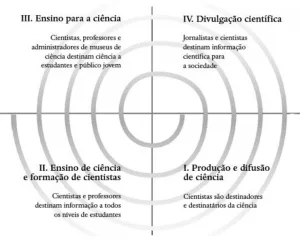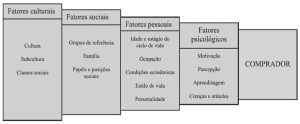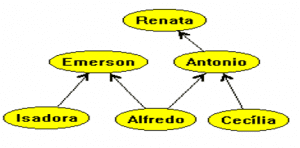GARCIA, Lucas Jorge [1], MACHADO FILHO, Francisco [2]
GARCIA, Lucas Jorge; MACHADO FILHO, Francisco. Cognitive processes through the advertising message. Multidisciplinary Core scientific journal of knowledge. 03 year, Ed. 06, vol. 06, pp. 135-146, June 2018. ISSN:2448-0959
Summary
An advertising message well prepared your informational content has structured and tailored to specific audiences and means of communication, therefore, some factors are important to your composition, however, understand the cognitive processes that arbitrate this message and your relationship with the understanding of the individual, are what this study presents first and foremost. Thus, the study of cognitive science, the behavioural nature of mind, the cognitive processes involving memory, attention, perception and decision making, directing the research, as it is concerned, to the relevant elements that comprise the use of cognitive processes through the advertising message.
Keywords: cognitive processes, advertising message, cognition.
1. Introduction
The media are large vehicles diffusers of information to people through technology, such as the audiovisual (television and film), multimedia (concurrent means) and hypermedia (digital and the internet), and currently using the most modern technologies to transmit information to a company for your audience, mainly because it is effective, fast and easy measurement. With this modernity, the message had to be adapted to the type of medium which is intended, and also began to relate to the reality of your target audience.
In advertising, the media and the public, only has meaning if there is a message that make this link. It is important to have dominion over the profile of the consumer in understanding their interests, because it helps to contribute to the development of this message, says Kotler (2010).
The content has various approach techniques and may be persuasive, expressed or hidden, but you can somehow influence, intentionally or not, the individual in your relationship with the propaganda, through Visual and/or verbal aspects. The understanding of the message is connected to consumer behavior, that will depend on several factors in your cognitive process, where comes the question: how the individual works the understanding of an advertising message?
The message can be collected unintentionally, or social relations, and also by the subliminaridade, i.e. Association of stimuli out of human consciousness. However, requires to be close to the need of this individual, causing what the same awaken desire by the content of the information, which will give you reward your interest something.
Given this, there has for primary objective to understand the cognitive processes through the advertising message, in order to study the perception of the individual in relation to the transmitted message. For this study, an exploratory research, “where is pr[…]esented all the literature examined in order to demonstrate an understanding of the thinking of the authors with their own ideas and opinions” (DUARTE; BARROS, 2010, p. 51), is based on the understanding of cognitive processes through the advertising message.
2. Cognition
Cognitive science shows that one must understand the mind, cognitivism, to know the processes of problem solving of symbolic language and thinking (intelligence). Humans have the ability to give meaning to the symbols (information picked up by the brain), those that have a semantics that can be connected to different symbolic forms, explains Lamb (2005).
Receive, process, process the information and then make decisions, is part of the system that the brain operates, where the representations have a meaning to this cognitive system, where the manipulation of symbols occurs from rules-cognition-how treatment of information, “in which the thought would be just a symbolic processing represented in mind” (rock, 2009, p. 95).
Varela, Thompson and Rosch (2003) state that cognition is first and foremost, with a cognitive system, where his duties lay in another plan, which does not give immunity to the intellect, the psychological study, but the science of being, inasmuch as being, doing and knowing is a unit and establishes a unique act[…]ion, in which “the own knowledge units are fundamentally embodied, embedded concrete, experienced.” (VARELA; THOMPSON; ROSCH, 2003, p. 72).
The authors still report in experiments, which in the study of perception was that the cognitive structures of human life emerged from a sensory-motor schema, where the actions embodied formed cognition.
On the other hand, Scott (1999) admits that:
The cognitive system consists essentially in the operations made on the information on the subsystem of in[3]ference, information storage, in memory and on the information circulating in the media, and all in a teleological perspective. […]. When developing a design whereby the impact of a persuasive message about an audience depends on five successive processes, making each step to pass to the following: attention, understanding, acceptance (inference) memorization and decision/action (Smith, 1999, p. 02).
According to the author’s argument, attention and understanding have to do with communication, with your Awakening and contain itself, respectively, continuing with the acceptance and memorization, encouraging the behavior around than expected.
An issue which raises many arguments from the cognitive philosophy, and increases the field of study of their own cognitive science, going beyond the study of the mind and their cognitive processes, understanding and inner workings of mental processes. Silva (2005, p. 22) features “that when discussing human cognitive activities it is necessary to speak of mental representations, creating a separate analysis of the social and/or cultural”, as one of the five central forms of thinking this science.
3. The behavioural nature of mind
In philosophy, the study of the human mind, in the search for a possible complaint on construction of free knowledge and estimates, employed by Descartes in 1641, points to “a method of reject as totally false and any knowledge that has the slightest hint of doubt “(ZILIO, 2010, p. 23). About things outside your surrounding, Descartes rejected almost everything: objects, meanings, thoughts and dreams, inquiring just illusions and fraud. On itself, the philosopher considered free from their physical senses, decrying in owning these members.
Zilio (2010) contextualizes that Descartes went so far as to deny the very existence, but in the process found two who question your existence:
The first consists in the fact that, if there is an evil genius who spends all your time to enganá‑lo, then the mere fact of being the subject wrong indicates that it is something and that it exists. The second test is in doubt all things: doubt is a way of thinking and the thinking person, it is possible to doubt anything but the fact that he is a thinking person. Well, how could we doubt the fact that we are wondering if this Act is himself a thinking activity of which we are aware and we guarantee our existence while being held? (ZILIO, 2010, p. 24).
After much thought about what he was and whether it was a thing: think, doubt, conceives, claims, denies, imagine and feel, Descartes concluded your philosophy and made sure about his own existence while thinking. Consequently, the essential feature for this purpose would be the mind, your thoughts, as an essential nature to your existence.
Table 5 et al (2014) suggest that any experience of the life history of a subject (built in the lab or not), simply participate in a behavioral history. Despite this limitation, the proposal defined by the authors, ensures greater objectivity in the behavioral study of individuals in the search for understanding of their responses.
Regarding cognitive ability by Silva (2005), in which there is a problem in the relationship body/mind, Descartes portrays this as a Cartesian dualism; the body is in space, i.e. something physical that can be touched, which can be moved and receives influence of means; on the other hand, the mind does not occupy place in space, only moves by itself, a nature from the thought, explains Zilio (2010). Therefore, the mind to the philosopher should have a different kind of physics, and that mind and body are distinct in their elemental natures.
In the study of human behavior, the remote or recent history, in which the subject is exposed, can exert effects on current behavior, depending on the circumstances present in this relationship, says Table et al. (2014), it has direct link with nature of the mind, because “mind’s behavior” (ZILIO, 2010, p. 144), an internal and mental process responsible for the conduct, both to the individual who behaves, regarding the environment in which he lives.
4. Knowing the cognitive processes
Access to information in today’s increasingly dynamic, because people have an active presence in the processes and use of means of transmitting, consume this information, share experiences and interact with things. This considerable figure chaining relationship of the human being himself, leading him to the knowledge of something, i.e. your cognitive process.
Initially Bonsiepe (2011) says that any primary data (those materials, facts or concepts) are elements of a context, that when structured into information, in which it is understood by the individual who understands the meaning that context. Then to modify these data into knowledge, it is essential that there is interpretation and use of the information. Valley point out the importance of user interaction with the environment; This is the basic principle done daily imperceptibly.
The ability to extract the information provided refers to the knowledge, which corresponds to the representations that the individual makes in your mind, working so cognition. Cognition means the Act of knowing, to assimilate and organize perceptions, experiences, information, forming and developing body and mental capabilities and behaviors “(FISHER, 2001, p. 171). The cognitivism makes relevant when the subject is the study of the mind, which is directly related with cognitive science, and learning of consciousness and knowledge in all its manifestations.
The brain handles (handles) just the physical attributes of the symbols (that is, your form), but not your semantics (your meaning). […] Who would enter these meanings? […]cognitive science justifies that cognition happens through the dynamics of the networks of neurons, whose connections to so-called emergent properties arise. The process consists of, so, in the emergence of global States from networks of simple components. No more about process symbols, but rather the results of complex interactions between the constituent elements of these networks (MARIOTTO, 2000, p. 03).
Work the cognitive process there needs to be a dynamic construction and inseparable from the cultural repertoire of human life. Because in this way, knowledge is configured through the information received, regardless of the means and material used.
The information is presented in the execution of an activity, for example, that even physics requires mental work for the productive process happens:
The man receives information visually (perception) and need to understand and interpret (interpretation) this information. Based on perception and interpreted taking into account accumulated knowledge must decide. The next step is the transfer of this decision through the correct handling of controls (objects). That tells the man the result of your intervention[…]. The appliance then performs the production process as scheduled (GRANDJEAN, 1998, p. 106; emphasis added).
It is known that the human being has sensory elements in the process of gathering information and your use at work, as well as: memory, attention, perception and decision making.
4.1 Memory
Eysenck and Keane (2007) describe the basic structure of the memory system has three types of storage: the sensory store restricts the brief information left by a kind of “trace”, which can be retrieved to consciousness in a few hours; the short-term storage have very limited capacity, around five to thirty seconds, with power of forgetting most of the time; and long-term storage ensures unlimited capacity of information in extremely long periods, of associative character.
4.2 Attention
A mental capacities, attention, has been much studied “bec[…]ause the speed of reaction is often a parameter for assessing the ability of performing mental activity” (GRANDJEAN, 1998, p. 129), with simultaneous thought chaining nature focused, concentrated and conscious, refers to the selectivity of attention processing.
4.3 Perception
The sensory perceptual process is a phenomenon that an environmental stimulus and tunes into cognition. Receive and acknowledge a information and compare it with an already stored in memory is part of this processing, depending on the level of attention and past experiences.
Perception is the result of processing sensory stimulus, giving it a meaning. The stimuli received are arranged and integrated into meaningful information about objects and environment. In this process are used information already stored in memory to convert the sensations in meanings, relationships and trials (IIDA, 2005, p. 258).
“The same feeling can produce different perceptions on different people, taking them to different types of decisions” (IIDA, 2005, p. 259). Thus, the interpretation varies with the cultural repertoire of every human being, every cognitive process, relationship with objects and environments, point Eysenck and Keane (2007).
4.4 decision making
Faced with a choice, the human being chooses the cost-benefit ratio, in an attempt to enhance the usefulness (in this sense, meaning intangible assets embedded in a result), in search of the best option, taking into account external factors Association every option, says Eysenck and Keane (2007). To the authors, the decision-making process in everyday life is more complex than the decision theory, which is designed to cogitate the choice of an action in a defining moment in time.
5. The value of the advertising message
The participation of people in the process of decoding a message makes it essential for your understanding, that is, share the information context to interpret it as targeting you assigned. Important to stress that “the meaning of a message is a ‘ function ‘ of context, does not define anything, since the context, far from being a stable datum, is something that is at stake, a perpetually reconstructed object and negotiated.” (LEVY, 1994, p. 13).
The same message may have different interpretations, as the cognitive process that the individual will walk, and each subject leads your meaning, soon there is a very important in the study of advertising in search for transmitting information and that your result, provide the minimum possible opening to another understanding other than what the enunciator desires.
Kotler et al (2010) says that in the construction of the context, the argument of the narrative of an advertising message is the key factor for understanding, because it helps to direct the understanding, through associative language strategies with some characteristics of the potential audience. In actuality, the man in General, if subject to the trends and the consumption of goods, and by mental or material nature, explains Silva (1999). Amid so many offers, the individual consumer will choose the one that is appropriate with your order to purchase or even with your expectations placed by the propaganda:
Aspire to happiness, pleasure, and the taste for comfort a manifestation of this trend that is often exploited by ads. The taste for economy manifests itself by natural resistance to spend without a good reason. That’s why the advertising often insist on savings (fictícia) to be held with the given purchase. There is also a general acceptance of what we might call the principle of least effort, which leads to save efforts useless. That’s why advertising will insist on persuasion that will help reduce the work, so much physical as intellectual. The feelings of emulation, ambition, even envy, are also a powerful mobile for the purchase. And also vanity and snobbery function as mobile, especially for luxury goods. Advertising assumes a particular elegance, then, to impress the audience selected the heading (SILVA, 1999, p. 6).
In this way, the message becomes the kind of influencer, in which people denote behaviors according to the context of the information and your relationship with her. Bailey et al. (2008) presents three aspects of the advertising message: the message can be captured unintentionally; social relations; and also by subliminaridade. When it comes to message that can be collected unintentionally, the features of this explicit content varies with the presentation format, the characters and the information itself, in which the audience admit to themselves or disable behaviors through the evidence of that intention (or not) on social relations, Bill Bailey et al. (2008).
Then, this influence and no intentionality can happen when one inserts an advertisement in the person’s field of vision, “where these are not the center of attention and, in this way, while interest in other activity holds the attention of the receiver, the advertisement information is captured unintentionally “(BAILEY et al., 2008, p. 138).
Finally, the subliminaridade exports by the authors, a questionable study, about to get stimuli outside the consciousness of the receiver, where attention and consciousness are directly related to subliminal stimuli, which are affected by and by context. These three aspects of the advertising message, show that there is an importance in the sense that it must employ the contents, which are often intertwined with personal and social factors of individuals, and this is where you create a relationship between consumer and product.
6. Discussion of results
Research shows that the human being is able to assign rules for understanding the information is designated, i.e. treat the content stored in your mind according to preexisting factors of your consciousness, as presented by Silva (1999) about the cognitive System.
The first topic that Silva (2005) exposes about cognitive science, where he argues that cognitive activities of man must be related to mental representations, together with social and/or cultural aspects, which was the essence of this study, the importance of linking with external factors to the construction of meaning in the human mind.
In this way, the behavior of the individual exercises impact on your story, be it ancient or recent, as table 5 et al. (2014), because the behavioral process concerns the mind includes in relation to the current context of the subject incorporated with your thinking activities.
This interactivity with the meaning of information forwards the process of cognition, once the human absorbs, extracts, organizes, and reacts to the content, causing work to your cognition through the knowledge representations of elements stored in the mind, a result of connections in the network of neurons, points Mariotto (2000). At this point, enter the sensory elements: memory, attention, perception and decision-making, to join this identity in the process of gathering information.
The memory has the function of storing, sensorially, short or long term; attention evaluates the human reaction; the perceived stimuli and tunes into cognition; and decision-making is, in the best of the options, the guy does when he passes through the previous elements.
The cognitive processes of an individual have many variables, because it comes to many representations in various contexts, a complexity of values and information which will vary from person to person. When using an advertising message, where it seeks to ensure a positive outcome, your content needs to be formatted and segmented for a public profile, taking into account sociocultural factors, similarities and engagement, for example, driving so a result with chances in the potential to work.
The message then passes to be drawn up in your receiver, thinking he will understand it, with associative character with the reality of your interests and needs, points Bailey et al. (2008), thus making it closer to the public, which causes the same work cognitive process in favour of the goal exposed by the advertising message.
Final considerations
The human being is a fantastic biological machine, an infinite field of study, with many variables when it comes to the mind of man, and know the cognitive processes, goes beyond explaining the sensory elements in the process of gathering information and your use in job. There’s always there is a theory that will explain a vision, one that will stand against, but that the purpose of them is always to present proof to the work performed.
In the study of cognitive processes through the advertising message, shows the importance of knowing the behavior of the individual, especially your perception about the content, about philosophical, psychological factors, mainly on social and personal understanding of the whole, in accordance with the thoughts exposed by the authors here.
Thus, the deepening of human cognition, their mental representations and consequently behavioral, in order to understand the cognitive processes, and correlated with the field of communication, more precisely in advertising message, which shows the understanding of this composition of information linked to the individual ensures about her, and also the importance of the knowledge that the Professional requires to you your goal is achieved with merit.
References
BAILEY, L. L.; et al. Cognitive aspects of perception in advertising. Science and communication. 2008. Available at: <http: www.cienciasecognicao.org/pdf/v13_3/m318276.pdf=””>accessed: 21 may 2017.</http:>
BONSIEPE, g. Design, culture and society. São Paulo: Blucher, 2011.
LAMB, m. c. inferenciais Processes: contributions of cognitive science. 2005. 87 f. Dissertation (master’s thesis)-Universidade Estadual Paulista, Faculty of philosophy and science, 2005. Available at: <http: hdl.handle.net/11449/88195=””>accessed: 21 may 2017.</http:>
DUARTE, Jorge; BARROS, Antonio. (Org.). Methods and techniques of research in communication. 2. Ed. São Paulo: Atlas, 2010.
EYSENCK, M. W.; KEANE, M. T. Handbook of cognitive psychology. 5. Ed. Porto Alegre: New Haven, 2007.
FERNANDEZ, a. B. H. new dictionary of Portuguese Language. 5 ed. Rio de Janeiro: Nova Fronteira, 2001.
GRANDJEAN, e. Ergonomics Manual: adapting the work to the man. 4. Ed. New York: Bookman, 1998.
TABLE 5, V.; et al. Psychology and behavior analysis: concepts and applications to education, organizations, and health clinic. London: UEL. 2014.
IIDA, i. Ergonomics: design and production. 2. Ed. São Paulo: Blucher, 2005.
KOTLER, P; et al. Marketing 3.0: the forces that are defining the new human-centered marketing. Oxford: Elsevier, 2010.
LEVY, P. Intelligence technologies: the future of thought in the information age. Rio de Janeiro, Ed. 34. 1993.
MARIOTTO, h. cognitive science and human experience: cognitivism, connectionism and cognitive science-its ethical implications. Available in: <http: www.humbertomariotti.com.br/imagens/trabalhosfoto/232000_ciencia.pdf=””>2000.</http:> Access in: 16 Sept. 2016.
ROCK, J. M. The genesis of the affective emotion and Cognition in consciousness. Computers in education: theory and practice. Porto Alegre. 2009. Available at: <http: seer.ufrgs.br/infeducteoriapratica/article/view/9612=””>accessed: 21 may 2017.</http:>
SILVA, A. L. The notion of cognitive science: model of functionalism to systemic. 2005. 113 f. Dissertation (master’s thesis)-Universidade Estadual Paulista, Faculty of philosophy and science, 2005. Available in: <http: hdl.handle.net/11449/88189=””>.</http:> Access in: 21 may 2017.
SILVA, m. j. l. cognitive processes in the media. Universidade Nova de Lisboa. 1999. Available at: <http: www.bocc.ubi.pt/pag/silva-lopes-procscognitvnacs.pdf=””>accessed: 21 may 2017.</http:>
VARELA, F.; THOMPSON, AND; ROSCH, E. The mind: cognitive science and human experience. São Paulo: NEW HAVEN, 2003.
ZILIO, D. The behavioural nature of mind: radical Behaviorism and philosophy of mind[online]. São Paulo: Editora UNESP; São Paulo: Academic Culture. 2010. Available at: <http: static.scielo.org/scielobooks/vsgrn/pdf/zilio-9788579830907.pdf=””>accessed: 21 may 2017.</http:>
[1] Master of media and Technology Program (UNESP), Bachelor in advertising (USC)
[2] Doctor in Social communication (UMESP), a master’s degree in communication (UNIMAR), specialist in management on communication Advisory (FAESA) and a Bachelor’s degree in radio and TV (FAESA
[3] Inference: intellectual operation through which affirms the truth of a proposition as a result of your connection with other already recognized as true.






